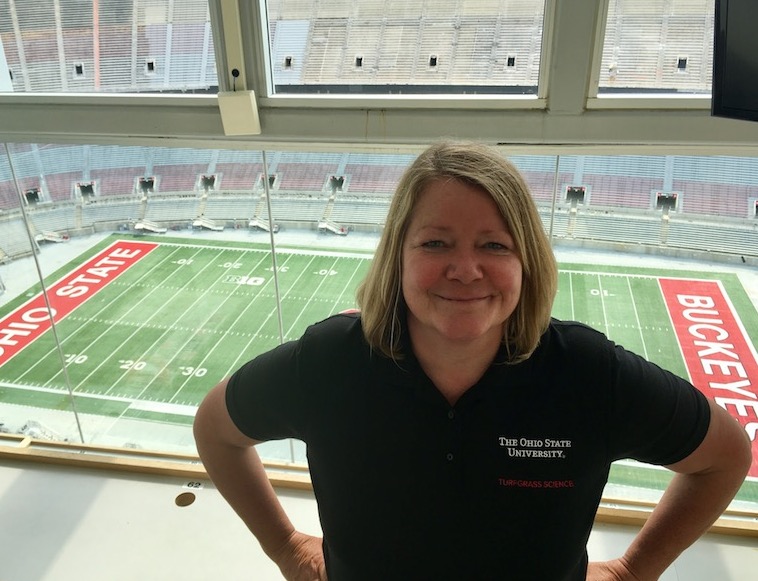By Pamela Sherratt
With the summer upon us, it’s important for sports field managers to protect themselves from sunburn and heat exhaustion, and to keep hydrated. I thought it might be interesting to take a look at how our cool-season turfgrass fare during the summer months, too.
Cool-season turfgrasses perform best when daytime temperatures are in the 60-75°F range and soil temperatures are in the 50-65°F range, along with adequate soil moisture. Solar radiation is the source of heat buildup in the turfgrass plant. Transpiration of water up through the plants and out of the stomatal pores dissipates the heat. The rate of transpirational flow is dependent on temperature, wind, solar radiation and humidity. It is regulated by the stomatal openings and by the static layer of air that covers the leaf blade (called the “boundary layer,” and held at 100% humidity). Once the boundary layer is removed by windy conditions, the movement of water via transpiration is increased. Thus, the rate of transpirational cooling is much greater on a sunny, windy day than a cloudy, calm day.
Dr. Karl Danneberger describes it as such:
- Clear sunny day, no breeze, and adequate soil moisture – The canopy temperature will be 15°F higher than the air temperature.
- Clear sunny day, slight breeze, adequate soil moisture – The canopy temperature will be within 1°F of the air temperature.
- Cloudy, no breeze, adequate soil moisture – The canopy temperature will be the same as the air temperature.
- If soil moisture is limiting, under sunny days the canopy temperature can rise 20°F above the air temperature.
- Heavy sand topdressing left on the turf surface can increase canopy temperatures 23°F.
The most common heat stress symptoms are a reduction in shoot growth and a stoppage or loss of a functional root system. In most cases, heat stress alone does not cause turf death. The impact of heat is often associated with detrimental changes to the plant that increase the likelihood of traffic or wear injury. Soil temperatures above the optimum are more detrimental than air temperature. When average daily soil temperatures exceed 70°F, 50% or more of the root system of a cool-season turfgrass can be lost.
Cool-season grasses are also susceptible to drought stress, and will go dormant in the summer if they do not get water. Turf can avoid drought stress by having deep roots, or an abundance of root hairs, a dense sward, rolled or hairy leaf blades, thick cuticles and/or small leaf areas.
The amount of water a turfgrass system needs is based upon its “water use rate” (WUR), which is calculated by the evapotranspiration (ET) rate. Compared to warm-season grasses, cool-season grasses have high water use rates during the summer, typically between 0.25 – 0.35 inches per day. ET rate is commonly used as a guide for the amount of supplemental irrigation needed each week if there is no rainfall. A ballpark figure would be that turfgrasses require 1-inch of water per week. Lower amounts than the weekly ET rate could also be applied if there was a severe drought, and the irrigation water was scarce or too expensive. It is not uncommon to see irrigation strategies of replenishing only 50-80% of the calculated ET rate in order to conserve moisture. If turf is allowed to go dormant in order to conserve moisture, it is important to regularly check the crown of the grass plant to make sure that is stays hydrated, or the turf may die. Turfgrasses with rhizomes or stolons are more able to withstand periods of drought than shallow-rooted, bunch type grasses.
It is essential during the spring months to promote as many roots as possible by alleviating soil compaction and by being judicious with both water and fertilizer. Spring is the best root growth growing period for cool-season grasses. Cultural practices to encourage root growth at that time of year will provide great dividends during summer stress.
Pamela Sherratt
Sports Turf Extension Specialist
The Ohio State University
Questions?
Send them to Pamela Sherratt at 202D Kottman Hall, 2001 Coffey Road, Columbus, OH 43210 or sherratt.1@osu.edu
Or send your question to Dr. Grady Miller, North Carolina State University, Box 7620, Raleigh, NC 27695-7620, or grady_miller@ncsu.edu



